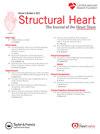The Prognostic Relevance of a New Bundle Branch Block After Transcatheter Aortic Valve Implantation: A Systematic Review and Meta-Analysis
IF 1.4
Q3 CARDIAC & CARDIOVASCULAR SYSTEMS
引用次数: 0
Abstract
Background
Interference with the cardiac conduction system is common after transcatheter aortic valve implantation (TAVI), manifesting as atrioventricular block, or more commonly, new-onset persistent left bundle branch block (NOP-LBBB). Bundle branch block results in ventricular dyssynchrony and reduced cardiac output and may be associated with a poorer prognosis. This systematic review and meta-analysis evaluates the prognostic impact of a left or right bundle branch block after TAVI.
Methods
A systematic review was performed of the following online databases: PubMed, Medline, Scopus, and Web of Science, including English language studies from 2014 to 2024. Two separate searches for conducted for NOP-LBBB and new-onset persistent right bundle branch block (NOP-RBBB). The Newcastle-Ottawa Scale was used to evaluate risk of bias.
Results
Twenty-three studies totaling 18875 patients were included for NOP-LBBB, whilst 5 studies with a total of 3525 patients were included for NOP-RBBB. NOP-LBBB was associated with higher all-cause mortality at 1 year (risk ratio [RR] 1.41 [95% CI 1.12-1.78], I2 = 49%, p < 0.01), cardiovascular mortality (RR 1.34 [95% CI 1.02-1.75], I2 = 60%, p = 0.02), heart failure-related rehospitalization (RR 1.56 [95% CI 1.31-1.84], I2 = 47%, p < 0.01), and permanent pacemaker implantation at 1 year (RR 3.05 [95% CI 2.39-3.89], I2 = 14%, p < 0.01). NOP-RBBB was not associated with higher all-cause mortality at 1 year (RR 1.74 [95% CI 0.88-3.46], I2 = 93%, p = 0.11), however increased the risk of pacemaker implantation at 1 year (RR 4.68 [95% CI 3.60-6.08], I2 = 67%, p < 0.01).
Conclusions
NOP-LBBB is associated with higher mortality and heart failure rehospitalization after TAVI, whilst both NOP-LBBB and NOP-RBBB increase the risk of permanent pacemaker implantation at 1 year after TAVI.
经导管主动脉瓣植入术后新的束状分支阻滞与预后的相关性:一项系统综述和荟萃分析
经导管主动脉瓣植入术(TAVI)后对心脏传导系统的干扰是常见的,表现为房室传导阻滞,或更常见的新发持续性左束支传导阻滞(NOP-LBBB)。束支阻滞导致心室非同步化和心输出量减少,并可能与较差的预后相关。本系统综述和荟萃分析评估了TAVI后左或右束支阻滞对预后的影响。方法系统回顾2014 - 2024年PubMed、Medline、Scopus和Web of Science等在线数据库,包括英语语言研究。分别对NOP-LBBB和新发持续性右束分支阻滞(NOP-RBBB)进行了两次搜索。采用纽卡斯尔-渥太华量表评估偏倚风险。结果NOP-LBBB共纳入23项研究,共18875例患者;NOP-RBBB共纳入5项研究,共3525例患者。NOP-LBBB与较高的1年全因死亡率相关(风险比[RR] 1.41 [95% CI 1.12-1.78], I2 = 49%, p <;0.01),心血管死亡率(RR 1.34 [95% CI 1.02-1.75], I2 = 60%, p = 0.02),心力衰竭相关再住院(RR 1.56 [95% CI 1.31-1.84], I2 = 47%, p <;0.01), 1年后永久起搏器植入(RR 3.05 [95% CI 2.39-3.89], I2 = 14%, p <;0.01)。NOP-RBBB与1年时较高的全因死亡率无关(RR 1.74 [95% CI 0.88-3.46], I2 = 93%, p = 0.11),但增加了1年时起搏器植入的风险(RR 4.68 [95% CI 3.60-6.08], I2 = 67%, p <;0.01)。结论snop - lbbb与TAVI术后更高的死亡率和心力衰竭再住院相关,而NOP-LBBB和NOP-RBBB均增加TAVI术后1年永久性起搏器植入的风险。
本文章由计算机程序翻译,如有差异,请以英文原文为准。
求助全文
约1分钟内获得全文
求助全文
来源期刊

Structural Heart
Medicine-Cardiology and Cardiovascular Medicine
CiteScore
1.60
自引率
0.00%
发文量
81
 求助内容:
求助内容: 应助结果提醒方式:
应助结果提醒方式:


